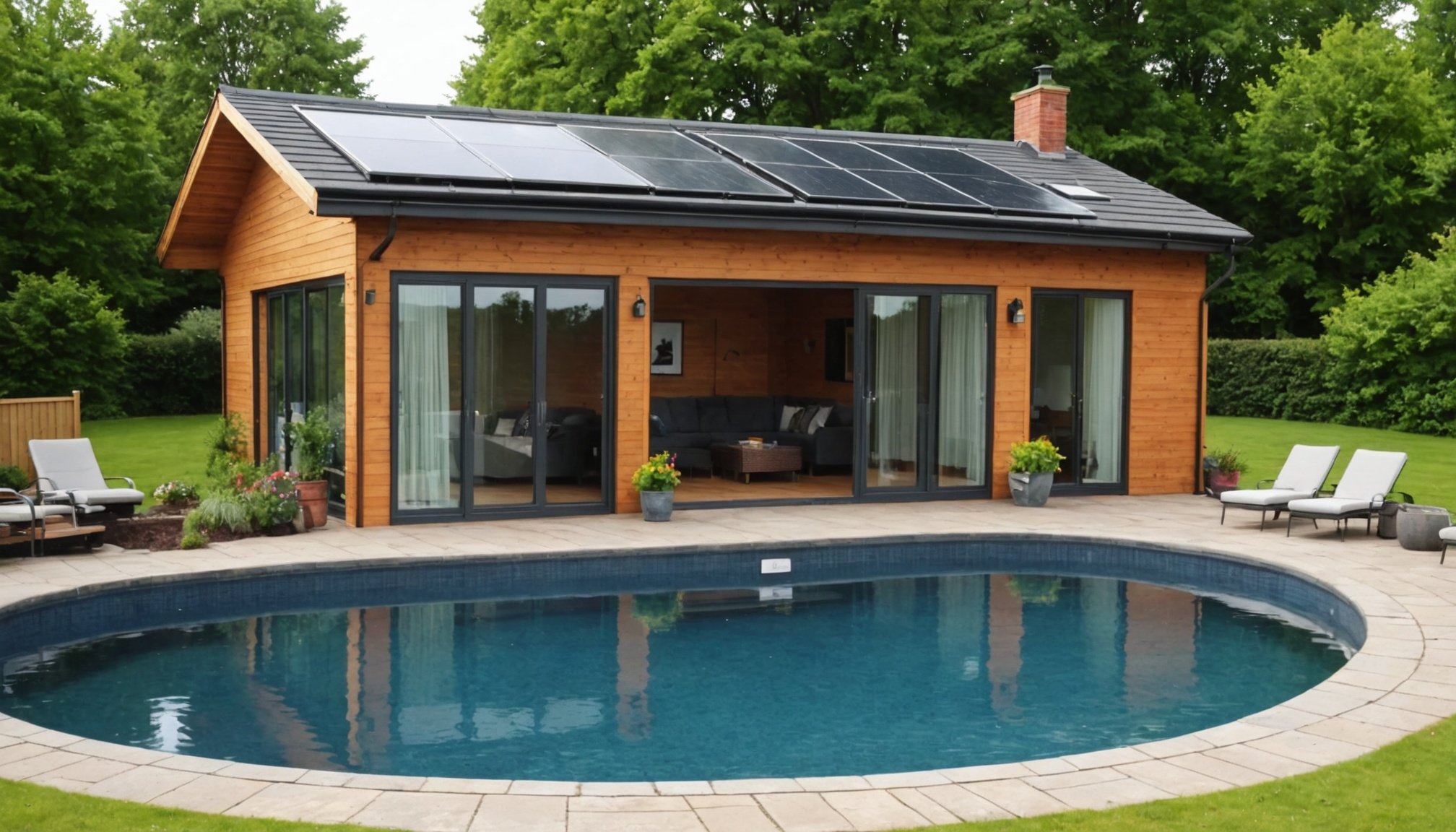Are you tired of high pool maintenance costs? Utilizing rainwater can transform your UK home swimming pool experience. Not only is it an eco-friendly solution, but it can also significantly reduce your water bills. This guide offers practical strategies for capturing, storing, and using rainwater to efficiently power your pool. Embrace sustainability and save money while enjoying a refreshing swim. Let's explore how to make the most of nature’s gift right in your backyard.
Understanding Rainwater Harvesting for Pool Use
Exploring sustainable practices and water conservation.
Lire également : How Your Garden Design Can Impact the Water Quality of Your UK Home Swimming Pool
Rainwater harvesting is an innovative and environmentally friendly approach to maintaining swimming pools, particularly in the context of the UK's growing emphasis on sustainable practices. By collecting and storing rainwater, pool owners can significantly reduce their reliance on municipal water supplies. This not only lowers water costs but also contributes to broader water conservation efforts, which are crucial given the increasing scarcity of water resources.
Benefits of Rainwater Harvesting for Pools
Highlighting the advantages of sustainable water management.
Sujet a lire : How do you manage algae and mold in damp UK climates?
- Cost Efficiency: Reduces water bills by utilizing a free natural resource.
- Environmental Impact: Decreases the demand on local water systems and reduces the carbon footprint associated with water treatment and distribution.
- Regulatory Compliance: Aligns with local and national guidelines promoting sustainable practices.
Sustainable Practices in the UK
An overview of eco-friendly water management techniques.
In the UK, sustainable practices such as rainwater harvesting are gaining traction as part of a broader commitment to environmental stewardship. The integration of rainwater systems into swimming pool maintenance reflects a proactive approach to water conservation. These systems typically involve the installation of gutters, downspouts, and storage tanks that collect and filter rainwater, making it suitable for pool use.
Importance of Water Conservation in Pool Maintenance
Understanding the role of conservation in pool care.
The importance of water conservation in swimming pool maintenance cannot be overstated. By adopting rainwater harvesting, pool owners not only conserve a vital resource but also ensure the sustainability of their leisure activities. This practice supports the long-term viability of water supplies and aligns with global efforts to address water scarcity.
"Water is the driving force of all nature." – Leonardo da Vinci
In summary, embracing rainwater harvesting for swimming pools represents a significant step towards sustainable living. By focusing on sustainable practices and water conservation, individuals can enjoy their pools while contributing positively to the environment.
Collecting and Storing Rainwater
Implementing effective systems for sustainable water use.
Best Practices for Installing Rainwater Collection Systems
When it comes to rainwater collection, there are several best practices to ensure efficiency and sustainability. Key components include positioning gutters and downspouts to maximize water capture from rooftops. It's crucial to use filters to remove debris before water enters the storage systems. Regular maintenance of these components helps in maintaining the system's effectiveness and longevity.
Types of Storage Solutions
Various storage solutions are available, each suited to different needs and capacities. Tanks, barrels, and cisterns are popular choices. Tanks are often large and can be above or below ground, providing substantial storage for collected water. Barrels are smaller, ideal for residential settings with limited space. Cisterns offer a versatile option, often used in larger properties or commercial settings. Selecting the right storage solution depends on the volume of rainwater you plan to collect and the available space for installation.
DIY Methods for Effective Rainwater Harvesting
For those interested in a hands-on approach, DIY methods provide a cost-effective way to implement rainwater harvesting. Simple setups can include connecting a rain barrel to a downspout, which can be completed with minimal tools and materials. More advanced DIY projects might involve constructing a custom cistern or integrating a pump system to facilitate water distribution. These methods allow for customization and adaptability, catering to individual needs and preferences.
"Rain is grace; rain is the sky descending to the earth." – John Updike
By understanding and applying these practices, individuals can effectively harness rainwater, contributing to sustainable water management.
Integrating Rainwater into Pool Systems
Exploring the integration of rainwater into pool plumbing for sustainable use.
Overview of Pool Systems Compatible with Rainwater Use
Integrating rainwater into pool systems involves understanding which types of pools can effectively utilize this resource. Generally, pools with advanced filtration systems are more compatible, as they can handle the additional particulates found in rainwater. Saltwater pools can also benefit from rainwater integration due to their lower reliance on chemical treatments, making them an eco-friendly choice.
Steps for Integrating Rainwater into Existing Pool Plumbing
To successfully incorporate rainwater into existing pool plumbing, several steps must be followed. Initially, assess the current plumbing system to determine compatibility with rainwater. Begin by installing a diversion valve that directs collected rainwater into the pool's filtration system. Ensure that the rainwater is pre-filtered to remove debris, thus minimizing potential contamination. Regular checks and maintenance of the system are crucial to ensure seamless integration.
Necessary Equipment and Modifications for Effective Integration
Effective integration of rainwater into pool systems requires specific equipment and modifications. Key components include rainwater storage tanks and filtration units designed to purify the water before it enters the pool. Installing a dedicated pump system is essential to facilitate the movement of rainwater from storage to the pool. Additionally, modifying existing plumbing to incorporate these elements ensures optimal performance and sustainability.
"The best time to plant a tree was 20 years ago. The second best time is now." – Chinese Proverb
By understanding these aspects, pool owners can effectively integrate rainwater into their pool systems, promoting sustainable water management and reducing environmental impact.
UK Regulations and Compliance
Exploring the legal framework for sustainable pool management.
Overview of Relevant UK Regulations for Rainwater Use
In the UK, regulations surrounding the use of rainwater for swimming pools are part of broader water usage laws aimed at promoting sustainability. These laws emphasize the need for compliance with environmental standards to ensure that rainwater harvesting systems are safe and effective. Pool owners must familiarize themselves with guidelines set by local authorities, which may vary depending on the region.
Compliance Requirements for Residential Swimming Pools
For residential swimming pools, compliance with UK regulations involves adhering to specific standards for rainwater collection and usage. This includes ensuring that all components of the rainwater harvesting system meet safety and quality benchmarks. Regular inspections may be required to verify that the system is functioning correctly and that the water quality is maintained. Pool owners should also be aware of any updates to water usage laws that could affect their compliance status.
Permits and Documentation Needed for Installation
Installing a rainwater harvesting system for pool use often requires obtaining the appropriate permits and completing necessary documentation. Local councils typically oversee the approval process, which ensures that installations align with existing water usage laws. Required documentation may include detailed plans of the system, proof of compliance with safety standards, and evidence of regular maintenance schedules. Fulfilling these requirements is essential for legal operation and to avoid potential fines.
"The journey of a thousand miles begins with one step." – Lao Tzu
By understanding and following these UK regulations, pool owners can effectively integrate rainwater systems into their properties, ensuring both environmental responsibility and legal compliance.
Cost Analysis and Financial Benefits
Exploring the economic advantages of rainwater harvesting for pools.
Initial Costs Versus Long-Term Savings
Implementing a rainwater harvesting system for your pool involves initial setup costs, which include purchasing equipment such as storage tanks and filtration units. While these initial expenses might seem significant, the long-term savings are compelling. By reducing reliance on municipal water supplies, pool owners can lower their water bills significantly over time. This cost reduction is particularly beneficial in regions where water prices are high, making rainwater harvesting a financially sound investment.
Potential Financial Incentives or Rebates in the UK
In the UK, there are potential financial incentives and rebates available for those who adopt sustainable practices like rainwater harvesting. These incentives aim to encourage individuals and businesses to invest in eco-friendly solutions. Local governments may offer rebates on installation costs or provide tax credits to offset the initial expenses. By taking advantage of these financial benefits, pool owners can further enhance the cost-effectiveness of their rainwater systems.
Case Studies Showcasing Cost-Effective Implementations
Several case studies highlight the cost-effectiveness of integrating rainwater harvesting into pool maintenance. For instance, a residential community in southern England implemented a comprehensive rainwater system, resulting in a 30% reduction in water bills within the first year. Another example is a leisure center that installed advanced filtration and storage solutions, leading to substantial savings and improved environmental compliance. These examples underscore the potential for significant financial benefits when adopting rainwater systems.
"An investment in knowledge pays the best interest." – Benjamin Franklin
By analyzing these aspects, pool owners can make informed decisions about the financial benefits of rainwater harvesting, ensuring both sustainability and economic efficiency.
Maintenance and Troubleshooting
Understanding the essentials of system care and problem-solving.
Regular Maintenance Practices for Rainwater Systems
To ensure the longevity and efficiency of rainwater systems, regular maintenance is crucial. Start by inspecting gutters and downspouts for debris accumulation, which can impede water flow. It's essential to clean these components periodically to maintain optimal performance. Additionally, check storage tanks for any signs of wear or leaks, as these can lead to water loss and system inefficiencies. Regularly servicing filtration units ensures that water quality remains high, preventing contaminants from entering the pool.
Common Issues and Troubleshooting Techniques
Despite careful maintenance, rainwater systems may encounter issues. A frequent problem is clogged filters, which can reduce water flow and affect pool water quality. To troubleshoot, inspect and clean filters regularly, replacing them if necessary. Another common issue is pump failure, often due to electrical faults or blockages. In such cases, check the power supply and clear any debris obstructing the pump. If problems persist, consult a professional to avoid further damage.
Tips for Ensuring Water Quality and Safety for Pool Use
Maintaining water quality is paramount for safe pool use. Use a water testing kit to regularly monitor pH and chlorine levels, ensuring they remain within safe limits. If rainwater is the primary source, consider adding a secondary filtration system to enhance water purity. Additionally, cover the pool when not in use to prevent debris accumulation and evaporation, which can impact water quality.
"An ounce of prevention is worth a pound of cure." – Benjamin Franklin
By adhering to these maintenance and troubleshooting practices, pool owners can ensure their rainwater systems operate efficiently, providing safe and sustainable water for pool use.
Case Studies and Successful Implementations
Exploring real-world examples of rainwater harvesting in the UK.
Highlighting Successful Rainwater Harvesting Projects
In the UK, numerous successful projects demonstrate the practical benefits of rainwater harvesting for pool use. One notable example is a community leisure center in Manchester, which integrated an advanced rainwater system into its facilities. This project not only reduced the center's reliance on municipal water by 40% but also enhanced its environmental credentials, attracting positive attention from both patrons and local authorities.
Lessons Learned from Practical Implementations
From these successful implementations, several key lessons emerge. Firstly, the importance of regular maintenance cannot be overstated; ensuring that filters and storage tanks are kept in optimal condition is crucial for system efficiency. Additionally, the need for thorough initial planning and design is highlighted, as these steps can prevent costly modifications later. The Manchester leisure center, for example, invested in high-quality filtration units from the outset, which minimized operational disruptions.
Insights from Homeowners and Pool Managers
Insights from homeowners and pool managers who have adopted rainwater harvesting systems reveal a strong sense of satisfaction. Many report significant cost savings and a greater sense of environmental responsibility. A homeowner in Surrey, who implemented a DIY rainwater system, noted the ease of installation and the immediate impact on water bills. Similarly, a pool manager in Bristol emphasized the system's role in achieving sustainability goals, stating:
"Our rainwater system has transformed our approach to water management, aligning perfectly with our commitment to sustainability."
Key Factors in Successful Projects
- Comprehensive Planning: Ensures systems meet specific needs.
- Quality Equipment: Invest in robust, reliable components.
- Community Engagement: Increases awareness and support.
By examining these case studies, individuals can gain valuable insights into the effective use of rainwater systems, encouraging more widespread adoption of sustainable practices.











